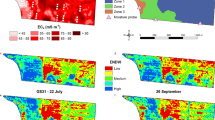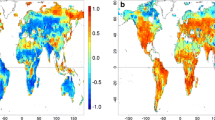Abstract
We tested the hypothesis that the date of the onset of net carbon uptake by temperate deciduous forest canopies corresponds with the time when the mean daily soil temperature equals the mean annual air temperature. The hypothesis was tested using over 30 site-years of data from 12 field sites where CO2 exchange is being measured continuously with the eddy covariance method. The sites spanned the geographic range of Europe, North America and Asia and spanned a climate space of 16°C in mean annual temperature. The tested phenology rule was robust and worked well over a 75 day range of the initiation of carbon uptake, starting as early as day 88 near Ione, California to as late as day 147 near Takayama, Japan. Overall, we observed that 64% of variance in the timing when net carbon uptake started was explained by the date when soil temperature matched the mean annual air temperature. We also observed a strong correlation between mean annual air temperature and the day that a deciduous forest starts to be a carbon sink. Consequently we are able to provide a simple phenological rule that can be implemented in regional carbon balance models and be assessed with soil and temperature outputs produced by climate and weather models.










Similar content being viewed by others
References
Aubinet M, Grelle A, Ibrom A, Rannik U, Moncrieff J, Foken T, Kowalski A, Martin P, Berbigier P, Bernhofer C, Clement R, Elbers J, Granier A, Grunwald T, Morgenstern K, Pilegaard K, Rebmann C, Snijders W, Valentini R, Vesala T (2000) Estimates of the annual net carbon and water exchange of European forests: the EUROFLUX methodology. Adv Ecol Res 30:113–175
Baldocchi DD, Hicks BB, Meyers TP (1988) Measuring biosphere-atmosphere exchanges of biologically related gases with micrometeorological methods. Ecology 69:1331–1340
Baldocchi D, Falge E, Gu LH, Olson R, Hollinger D, Running S, Anthoni P, Bernhofer C, Davis K, Evans R, Fuentes J, Goldstein A, Katul G, Law B, Lee XH, Malhi Y, Meyers T, Munger W, Oechel W, Paw UKT, Pilegaard K, Schmid HP, Valentini R, Verma S, Vesala T, Wilson K, Wofsy S (2001) FLUXNET: A new tool to study the temporal and spatial variability of ecosystem-scale carbon dioxide, water vapor, and energy flux densities. B Am Meteorol Soc 82:2415–2434
Baldocchi DD, Xu L, Kiang N (2004) How plant functional-type, weather, seasonal drought, and soil physical properties alter water and energy fluxes of an oak-grass savanna and an annual grassland. Agric For Meteorol 123:13–39
Billesbach D, Fischer M, Torn M, Berry J (2004) A portable eddy covariance system for the measurement of ecosystem-atmosphere exchange of CO2, water vapor, and energy. J Atmos Ocean Tech 21:639–650
Black T, Chen W, Barr A, Arain M, Chen Z, Nesic Z, Hogg E, Neumann H, Yang P (2000) Increased carbon sequestration by a boreal deciduous forest in years with a warm spring. Geophys Res Lett 27:1271–1274
Blanken PD, Black TA, Neumann HH, den Hartog G, Yang PC, Nesic Z, Lee X (2001) The seasonal water and energy exchange above and within a boreal aspen forest. J Hydrol 245:118–136
Brugger R, Dobbertin M, Krauchi N (2003) Phenological variation of forest trees. In: Schwartz MD (ed) Phenology: an integrative environmental science. Kluwer, Dordrecht, pp 255–268
Cayan D, Kammerdiener S, Dettinger M, Caprio J, Peterson D (2001) Changes in the onset of spring in the western United States. B Am Meteorol Soc 82:399–415
Chuine I, Kramer K, Hanninen H (2003) Plant development models. In: Schwartz MD (ed) Phenology: an integrative environmental science. Kluwer, Dordrecht, pp 217–235
Falge E, Baldocchi D, Olson R, Anthoni P, Aubinet M, Ch B, Burba G, Ceulemans R, Clement R, Dolman H, Granier A, Gross P, Grunwald T, Hollinger D, Jenson NO, Katul G, Keronen P, Kowalski A, Lai CT, Law B, Meyers T, Moncrief J, Moors EJ, Munger W, Pilegaard K, Rannik U, Rebmann C, Sukyer A, Tenhunen J, Tu K, Verma S, Vesala T, Wilson K, Wofsy S (2001) Gap filling strategies for defensible annual sums of net ecosystem exchange. Agric For Meteorol 107:43–69
Falge E, Baldocchi D, Tenhunen J, Aubinet M, Bakwin P, Berbigier P, Bernhofer C, Burba G, Clement R, Davis KJ (2002) Seasonality of ecosystem respiration and gross primary production as derived from FLUXNET measurements. Agric For Meteorol 113:53–74
Fitzjarrald D, Acevedo O, Moore K (2001) Climatic consequences of leaf presence in the eastern United States. J Climate 14:598–614
Freedman J, Fitzjarrald D, Moore K, RK S (2001) Boundary layer clouds and vegetation-atmosphere feedbacks. J Climate 14:180–197
Goulden ML, Munger JW, Fan SM, Daube BC, Wofsy SC (1996a) Measurements of carbon sequestration by long-term eddy covariance: methods and a critical evaluation of accuracy. Global Change Biol 2:169–182
Goulden ML, Munger JW, Fan S-M, Daube BC, Wofsy SC (1996b) Exchange of carbon dioxide by a deciduous forest: response to interannual climate variability. Science 271:1576–1578
Granier A, Pilegaard K, Jensen NO (2002) Similar net ecosystem exchange of beech stands located in France and Denmark. Agric For Meteorol 114:75–82
Griffis TJ, Black TA, Morgenstern K, Barr AG, Nesic Z, Drewitt GB, Gaumont-Guay D, McCaughey JH (2003) Ecophysiological controls on the carbon balances of three southern boreal forests. Agric For Meteorol 117:53–71
Gu L, Post WM, Baldocchi DD, Black A, Verma S, Vesala T, Wofsy S (2003) Phenology of Vegetation Photosynthesis. In: Schwartz MD (ed) Phenology: an integrative science. Kluwer, Dordrecht, pp 467–488
Hamming RW (1989) Digital filters, 3rd edn. Dover, Mineola, N.Y.
Hollinger DY, Aber J, Dail B, Davidson EA, Goltz SM, Hughes H, Leclerc MY, Lee JT, Richardson AD, Rodrigues C, Scott NA, Achuatavarier D, Walsh J (2004) Spatial and temporal variability in forest-atmosphere CO2 exchange. Global Change Biol 10:1689–1706
Jackson RB, Lechowicz MJ, Li X, Mooney HA (2001) Phenology, growth, and allocation in global terrestrial productivity. In: Roy J, Saugier B, Mooney HA (eds) Terrestrial global productivity: past, present, and future. Academic, San Diego, pp 61–82
Knohl A, Schulze E-D, Kolle O, Buchmann N (2003) Large carbon uptake by an unmanaged 250-year-old deciduous forest in Central Germany. Agric For Meteorol 118:151–167
Kramer K, Leinonen I, Loustau D (2000) The importance of phenology for the evaluation of impact of climate change on growth of boreal, temperate and Mediterranean ecosystems, an overview. Int J Biometeorol 44:67–75
Lee XH, Fuentes JD, Staebler RM, Neumann HH (1999) Long-term observation of the atmospheric exchange of CO2 with a temperate deciduous forest in southern Ontario, Canada. J Geophys Res 104:15975–15984
Massman WJ, Lee X (2002) Eddy covariance flux corrections and uncertainties in long-term studies of carbon and energy exchanges. Agric For Meteorol 113:121–144
McNaughton KG, Spriggs TW (1986) A mixed-layer model for regional evaporation. Bound-Lay Meteorol 34:243–262
Menzel A, Fabian P (1999) Growing season extended in Europe. Nature 397:659
Moore KE, Fitzjarrald DR, Sakai RK, Goulden ML, Munger JW, Wofsy SC (1996) Seasonal variation in radiative and turbulent exchange at a deciduous forest in central Massachusetts. J Appl Meteorol 35:122–134
Morecroft MD, Stokes VJ, Morison JIL (2003) Seasonal changes in the photosynthetic capacity of canopy oak (Quercus robur) leaves: the impact of slow development on annual carbon uptake. Int J Biometeorol 47:221–226
Myneni RB, Keeling CD, Tucker CJ, Asrar G, Nemani RR (1997) Increased plant growth in the northern high latitudes from 1981 to 1991. Nature 386:698–702
Nizinski J, Saugier B (1988) A model of leaf budding and development for a mature Quercus forest. J Appl Ecol 25:643–652
Penuelas J, Filella I (2001) Phenology: responses to a warming world. Science 294:793–795
Pilegaard K, Hummelshoj P, Jensen NO, Chen Z (2001) Two years of continuous CO2 eddy-flux measurements over a Danish beech forest. Agric For Meteorol 107:29–41
Raulier F, Bernier PY (2000) Predicting the date of leaf emergence for sugar maple across its native range. Can J For Res 30:1429–1435
Schaber J, Badeck F-W (2003) Physiology-based phenology model for tree species in Germany. Int J Biometeorol 47:197–201
Schmid HP (2002) Footprint modeling for vegetation atmosphere exchange studies: a review and perspective. Agric For Meteorol 113:159–183
Schmid HP, Grimmond CSB, Cropley F, Offerle B, Su H-B (2000) Measurements of CO2 and energy fluxes over a mixed hardwood forest in the mid-western United States. Agric For Meteorol 103:357–374
Schmid HP, Su H-B, Vogel CS, Curtis PS (2003) Ecosystem-atmosphere exchange of carbon dioxide over a mixed hardwood forest in northern lower Michigan. J Geophys Res DOI 10.1029/2002JD003011
Schwartz MD, Karl TR (1990) Spring phenology-natures experiment to detect the effect of green-up on surface maximum temperatures. Mon Weather Rev 118:883–890
Schwartz M, Crawford T (2001) Detecting energy balance modifications at the onset of spring. Phys Geogr 22:394–409
Shabanov NV, Wang Y, Buermann W, Dong J, Hoffman S, Smith GR, Tian Y, Knyazikhin Y, Myneni RB (2003) Effect of foliage spatial heterogeneity in the MODIS LAI and FPAR algorithm over broadleaf forests. Remote Sens Environ 85:410–423
Spano D, Cesaraccio C, Duce P, Snyder R (1999) Phenological stages of natural species and their use as climate indicators. Int J Biometeorol 42:124–133
Suni T, Berninger F, Vesala T, Markkanen T, Hari P, Makela A, Ilvesniemi H, Hanninen H, Nikinmaa E, Huttula T, Laurila T, Aurela M, Grelle A, Lindroth A, Arneth A, Shibistova O, Lloyd J (2003) Air temperature triggers the recovery of evergreen boreal forest photosynthesis in spring. Global Change Biol 9:1410–1426
Suyker AE, Verma S (1993) Eddy correlation measurements of CO2 flux using a closed path sensor-theory and field-tests against an open-path sensor. Bound-Lay Meteorol 64:391–407
Taylor F (1974) Phenodynamics of production in a mesic deciduous forest. In: Leith H (ed) Phenology and seasonality modeling. Springer, Berlin Heidelberg New York, pp 237–254
Tucker C, Slayback D, Pinzon J, Los S, Myneni R, Taylor M (2001) Higher northern latitude normalized difference vegetation index and growing season trends from 1982 to 1999. Int J Biometeorol 45:184-190
Valentini R, DeAngelis P, Matteucci G, Monaco R, Dore S, Scarascia-Mugnozza GE (1996) Seasonal net carbon dioxide exchange of a beech forest with the atmosphere. Global Change Biol 2:199–207
White MA, Running SW, Thornton PE (1997) A continental phenology model for monitoring vegetation responses to interannual climate variability. Global Biogeochem Cycles 11:217–234
White M, Running S, Thornton P (1999) The impact of growing-season length variability on carbon assimilation and evapotranspiration over 88 years in the eastern US deciduous forest. Int J Biometeorol 42:139–145
White MA, Brunsell NA, Schwartz MD (2003) Vegetation phenology in global change studies. In: Schwartz MD (ed) Phenology: an integrative environmental science. Kluwer, Dordrect, pp 453–466
Wilson KB, Baldocchi DD (2000) Seasonal and interannual variability of energy fluxes over a broadleaved temperate deciduous forest in North America. Agric For Meteorol 100:1–18
Wilson KB, Baldocchi DD (2001) Comparing independent estimates of carbon dioxide exchange over five years at a deciduous forest in the southern United States. J Geophys Res 106:34167–34178
Xu L, Baldocchi DD, Tang J (2004) How soil moisture, rain pulses and growth alter the response of ecosystem respiration to temperature. Global Biogeochem Cyles DOI 10.1029/2004GB002281
Yamamoto S, Murayama S, Saigusa N, Kondo H (1999) Seasonal and inter-annual variation of CO2 flux between a temperate forest and the atmosphere in Japan. Tellus 51B:402–413
Acknowledgements
We thank the technicians, students and postdoctoral students who helped collect data at all the field sites and the funding agencies that supported the numerous team. The senior author is supported by the NASA FLUXNET project and DOE Terrestrial Carbon Program (DE-FG0203ER63638)
Author information
Authors and Affiliations
Corresponding author
Rights and permissions
About this article
Cite this article
Baldocchi, D.D., Black, T.A., Curtis, P.S. et al. Predicting the onset of net carbon uptake by deciduous forests with soil temperature and climate data: a synthesis of FLUXNET data. Int J Biometeorol 49, 377–387 (2005). https://doi.org/10.1007/s00484-005-0256-4
Received:
Revised:
Accepted:
Published:
Issue Date:
DOI: https://doi.org/10.1007/s00484-005-0256-4




